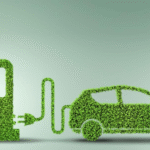Mitigating Risk in EV Financing: Strategies and Techniques for EV Lenders – Electric Vehicles (EVs) are reshaping the automotive industry as a sustainable option to gasoline-fueled vehicles. But their financing presents difficulties that do not appear with traditional auto lending. The innate costs are huge, technology is quickly advancing, depreciation from battery size is uncertain, and regulations are growing fast with every day that passes.
All these components are risk factors that traditional auto lenders mainly do not encounter in the time of the auto lending practice. This blog explores some of the strategies and techniques you can use to limit risks when considering EV financing and how that will benefit your dealership from an auto financing, sustainability, and profitable perspective.
Think about risk when financing EVs
Depreciation and secondary market risk
EVs depreciate more significantly than internal combustion engine (ICE) vehicles. This depreciation has a complex valuation equation with battery degradation, technological obsolescence, and a less wide secondary market for EVs that complicates predicting the value.
The uncertainty of battery performance and lifespan
The battery is the most costly element in the EV, and the performance of the battery after post sale of the vehicle affects customer satisfaction and residual value. Therefore, when the lender service team structures financing agreements, the lender must also think about battery assurances, replacement options, and battery performance uncertainty.
Market and regulatory risk
Governments around the world are promoting EV adoption with incentive programs, tax benefits, and regulatory mandates. Government-induced regulations are dynamic and do not always transfer over to vehicle demand or residual value. Lenders need to be updated and highly aware of the current guidelines and changes that are effective.
Problems with Infrastructure and Adoption
The increase of charging stations affects whether or not a customer adopts an EV and how much an EV is being utilized when the customer has adopted one. Lenders need to assess the impact that differences in regional charging infrastructure support will have on borrowing consumers’ capability to fully use EVs.
Technology Obsolescence and Consumer Preference
Because technology frequently develops quickly and improvements appear regularly, it becomes more common for the latest EVs to have better range, enhanced battery recharge time, and more effective technology than the previously existing models. This results in older EVs depreciating faster, ultimately affecting loan and lease value.
Solutions to Help in Risk Management for EV Financing and Leasing Companies
Buy Back Programs
Lenders can also work with manufacturers in providing residual value insurance guarantees or residual value guarantees from a third-party insurance firm, thereby lowering exposure to depreciation and removing uncertainty about future resale value from the borrower.
Battery Performance Guarantees
Lenders may think about working with manufacturers that provide extended warranty coverage on batteries, as this reduces battery concerns for the lender. Some lenders have discussed a battery leasing concept where the customer is the vehicle owner but the battery is financed separately.
Flexible Loan and Lease Structure
Given the uncertain chances for EVs and the highest resale price prediction, shorter loan lengths, lease options that can be different in length or structure, and charging based on noted mileage can all lower risks due to depreciation and technology obsolescence.
Using Complete Credit Risk Assessment
Consumer credit scoring does not speak to the totality of the EV buyer’s financial picture. Energy savings, maintenance costs, and total cost of ownership could offer other factors to think about when assessing reliability.
Incentive-Driven Financing Models
Using government subsidies, tax credits, and incentives from the manufacturers of EVs can create better financing opportunities. Lenders must educate customers on what incentives are available and how to structure the financing to take the most benefit of the incentive.
Relationships with Charge Network Providers
Connecting with charging networks to offer bundled deal financing would include home chargers or discounted rates at public charging stations. This not only builds value to the borrower but also helps lending performance.
Data-driven Risk Management
The use of telematics and real-time vehicle data could provide lenders with the ability to track usage patterns, performance, and battery health. This insight could provide information to help manage risk early on to avoid future losses.
Secondary Market Development Initiatives
Supporting certified pre-owned EV programs in partnership with resale marketplaces can enhance the liquidity of the used EV marketplace. A strong secondary market provides greater confidence in residual values and decreased default risk.
Future Outlook for EV Financing
As EV adoption continues to gain momentum, financial institutions will need to develop and adapt their risk mitigation strategies. Innovations such as battery-as-a-service (BaaS), ownership tracking via blockchain, and AI-enabled contracted loan underwriting will continue to develop best practices for EV financing. By evaluating and embracing trends in the marketplace and strategic partnerships, lenders can lobby to mitigate risk while being positioned to take advantage of the accruing benefits of the growing EV marketplace.
Conclusion
Reducing risk over EV financing can be achieved through multifaceted methods that reduce variables in market finance, market realities, new technology, and changing consumer behaviour. Exploring methodologies for risk management like flexibility of finance, battery performance guarantees, and data-led innovation-making will enable lenders to identify opportunities that reduce risk while adopting a sustainable future of automotive lending.
FAQs
What methods do lenders use to address the depreciation risk associated with EVs?
Lenders address depreciation risk using residual value guarantees, flexible lease terms that are flexible, and partnerships with resale marketplaces. They also keep track of battery health and advancements in technology when determining resale values.
What significance does battery health present as a risk assessment when issuing EV financing?
Battery health is important in evaluating the expected life of the vehicle and potential resale value. Lenders look closely at warranties for batteries, analyze data on usage, and note any patterns with degradation to develop a financing term to account for any risk in this area.
How can government incentives influence EV financing?
Government incentives, such as tax credits and subsidies, may reduce the direct cost of EV ownership and improve a loan’s affordability. Lenders may integrate these government incentives into the financing package to maximize customer benefits and reduce default risk.









